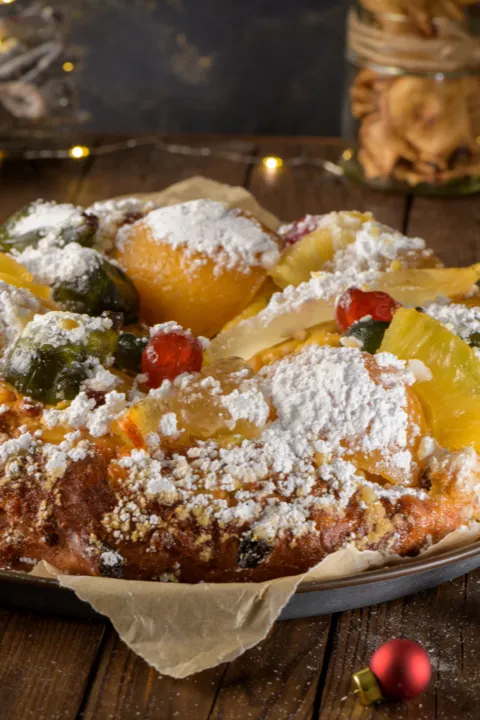THE KING CAKE, IN A CHRONICLE IN THE STYLE OF ANTONIO TABUCCHI*
The King Cake, Sovereign on Portuguese Christmas Tables
A timid yet cozy flame crackles in the fireplace, while at the table, a tradition is about to be unfolded. Year after year, Christmas after Christmas, this tradition is an inevitable chapter of Portuguese culture: the King Cake moment. Seated before the festive banquet, I observe the eager guests, each with their own theory about which one is the best slice.
Amidst laughter and toasts, the table is a stage for blended flavors and traditions. The King Cake, majestic in its sugar mantle and always accompanied by a proper Port wine, is the star of this Christmas party. Like a master of ceremonies, it announces the arrival of the celebration; it officiates the spirit of the season.
The King Cake, sovereign on Portuguese Christmas tables, is a small gastronomic masterpiece. From royalty, it inherited the crown-shaped form studded with precious jewels, in this case, the exuberant crystallized fruits, with vivid and bright colors. It is a majestic and festive cake. Its soft, slightly buttery leavened dough generously envelops nuts like walnuts, almonds, hazelnuts, and pine nuts, along with crystallized fruits, providing an explosion of flavors in every slice. The origin of the name dates back to the tradition of the Magi/ Three Kings Day, celebrated on Epiphany Day, January 6, marking the visit of the three kings to baby Jesus. The King Cake gained popularity on Portuguese tables in the 19th century, bringing with it the richness of ingredients that symbolize abundance and sharing, essential in this festive season.
The King Cake is the heir of beautiful traditions, such as the mythical broad bean and the surprise trinket. The dried broad bean, inserted into the dough, was a kind of game that added fun to the tradition. The one who found the bean in their slice was traditionally responsible for funding the King Cake the following year. The trinket, a small surprise hidden in the dough, used to be any low-quality metal object that thrilled the children who contested it. However, modern health regulations and legitimate concerns about the possibility of these elements causing undesirable obstructions and choking hazards almost made them disappear from the scene, turning them into a nostalgic charm of the past.
Gathered there, we did cut together, in a gesture of communion, the highest symbol of Portuguese Christmas. Each slice is more than a mixture of nuts and crystallized fruits. Each slice is a piece of history, a link between the present and the memories of past Christmases.
In a country that embraces its traditions fervently, the King Cake is more than just a Christmas treat; it is a narrative that unfolds with every bite. In its layers, we find the heritage of centuries of conviviality, the sweetness of nostalgia, and the warmth of a Portuguese home.
* This chronicle, seeking to recreate the style of the Italian writer Antonio Tabucchi, known for his love for Portugal and its literature (having obtained Portuguese nationality himself in 2004), was woven in a unique collaboration between artificial intelligence and human creativity. May these words serve as a tribute to the richness of traditions, and may the spirit of the King Cake, with its layers of history and flavor, continue to bring generations together around the table for many years to come.
